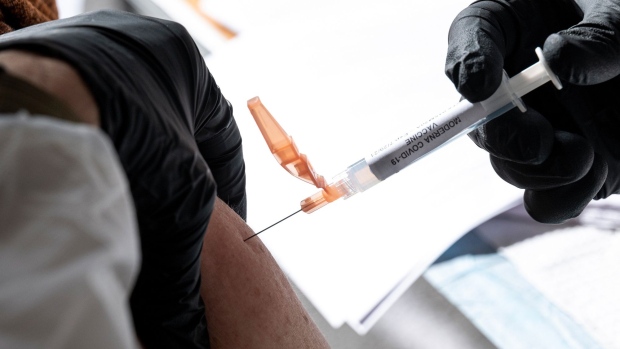Jun 16, 2021
Pockets of Unvaccinated Americans Threaten to Prolong Pandemic
, Bloomberg News

(Bloomberg) -- As much of the country emerges from masking and social distancing, undervaccinated pockets in the U.S. still threaten to bring the virus roaring back.
Less than 25% of the population is fully vaccinated in at least 482 counties, according to an analysis of Centers for Disease Control and Prevention data by Bloomberg News. Many of these counties are more rural and less economically advantaged than the rest of the U.S., and a majority of their voters in the last presidential election chose Donald Trump, according to the analysis of 2,700 U.S. counties.
Though more than 174 million Americans have received at least one dose of a vaccine, accounting for about 64.6% of the adult population, such averages belie stark gaps in vaccination rates at a local level. With more contagious versions of the virus like the delta variant taking hold, this creates opportunities for further spread.
Hidden pockets of low rates of vaccinations at the local level have been a challenge before in the U.S. “When you start to look at communities, you start to really unveil very, very low vaccination rates that tend to get averaged out when you're looking at the entire country or even on an entire state,” said Maimuna Majumder, a health informatics researcher at Boston Children’s Hospital. Viruses don’t spread at a national or statewide level, she said, but among friends, family and neighbors in a community, passing it to each other as people go about their daily lives.
The country’s past experience with measles, for instance, shows just what it’s up against with Covid. The World Health Organization declared in 2000 that measles had been eliminated from the U.S. Yet in 2014 amid declining childhood vaccinations, more than 600 cases appeared. Even so, overall measles vaccination rates hadn’t changed significantly in well over a decade.
After a high-profile outbreak of measles was traced back to Disneyland in early 2015, Majumder examined local data. It turned out that the vaccination rates in the communities affected by the Disneyland outbreak ranged from 50 to 86% — far lower than statewide or national averages, and also below the vaccination threshold needed to keep the measles from spreading. More digging revealed almost half the counties in 43 states had vaccination rates below that threshold, with huge variations. The pockets of under-vaccination explained the outbreak where the averages could not. In 2019, the U.S. had the biggest measles outbreak in recent years, with more than 1,200 cases.
“I didn't think we should be ignoring this problem before this pandemic began. I think it’s even more important now,” she said.
A lack of easy access to the vaccine is likely responsible for some current hesitancy, according to Majumder. Though the vaccine is free, factors other than price can get in the way for some.
“These are people who won't be able to take time off either to get the vaccine or recover from any side effects they may incur,” Majumder said.
But a large group of holdouts, she said, are likely skeptics of the Covid vaccine. Polling by the Kaiser Family Foundation suggests that about 13% of Americans plan to avoid the vaccine no matter what, while another 12% say they are waiting before making a decision and 7% will get vaccinated only if required.
“We need to disentangle what percentage of these under-vaccinated pockets are due to skepticism and true hesitancy and what percentage is really due to access still being an issue,” she said.
Investigating the root causes of hesitancy in these pockets can yield important insights, said Timothy Callaghan, who studies rural health at Texas A&M University. Political affiliation, he said, is often only part of the story. “There are a lot of other factors at play,” he said.
Texas, for example, has a lower vaccination rate than a blue state like Connecticut, but also a larger rural population and more people of color, two other factors for which polling suggests hesitancy is more common.
Not all pockets, moreover, line up neatly with statewide demographics. New York state, for example, has been a leader in vaccinating its population with more than 67% of adults having received at least one dose of a vaccine. On Tuesday, Governor Andrew Cuomo said that enough adults had been vaccinated for the state to lift its remaining pandemic restrictions.
Bloomberg’s analysis revealed pockets where less than 25% of the population were vaccinated, the average population was 64,000 compared to 1.29 million in more vaccinated areas. The median annual income in these places was $48,600 compared to $66,100 in vaccinated areas. And of those in less vaccinated areas, 72.1% voting in the last presidential election cast their ballots for Trump.
“If certain groups are less likely to vaccinate, it makes it more likely that Covid-19 will continue to be a high risk in certain communities,” Callaghan said. “And if Covid continues to spread in certain areas and then people go to visit those areas, they become at risk.”
To address this hesitancy, the most important task may be to dig deeper into the myriad reasons people are opting out of vaccination.
“The first thing is to recognize that a sort of one-size-fits-all approach isn't going to work,” Callaghan said.
©2021 Bloomberg L.P.